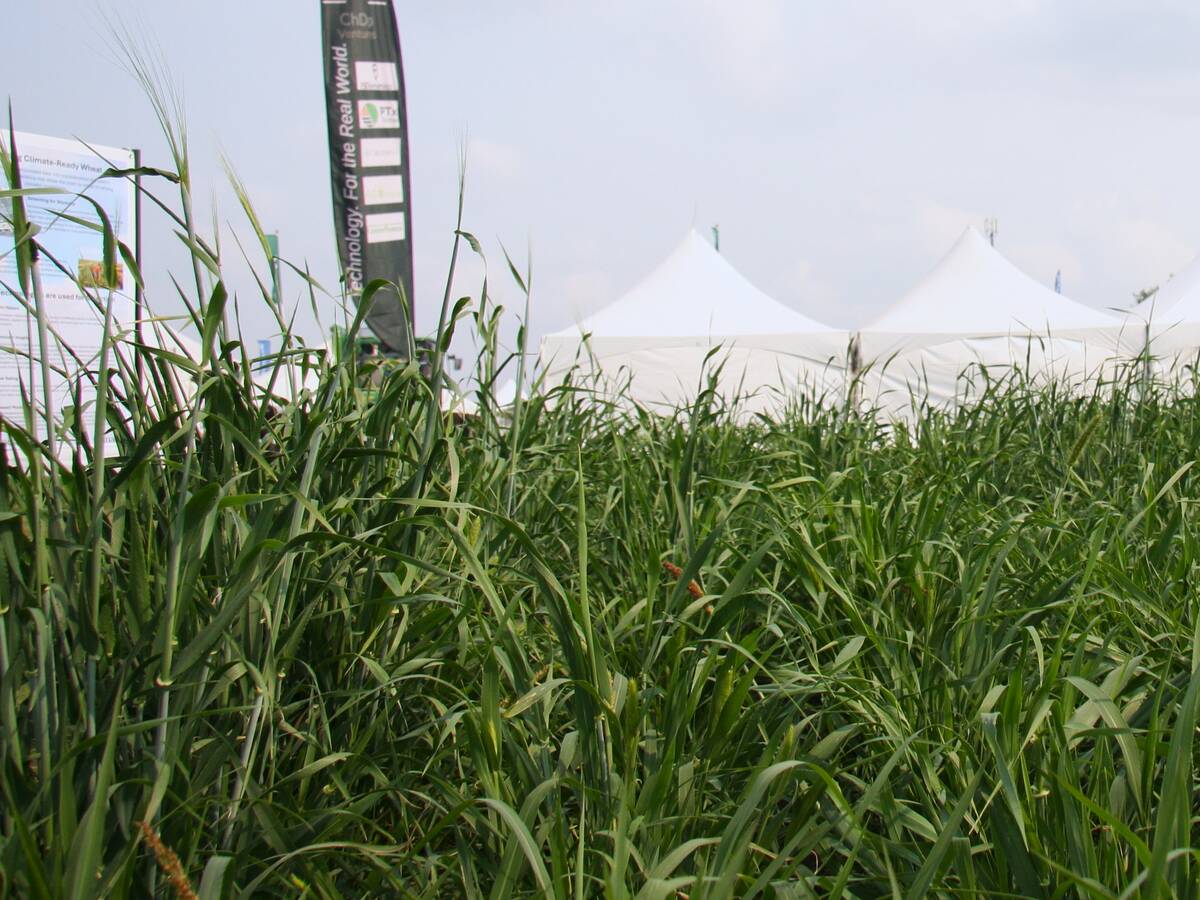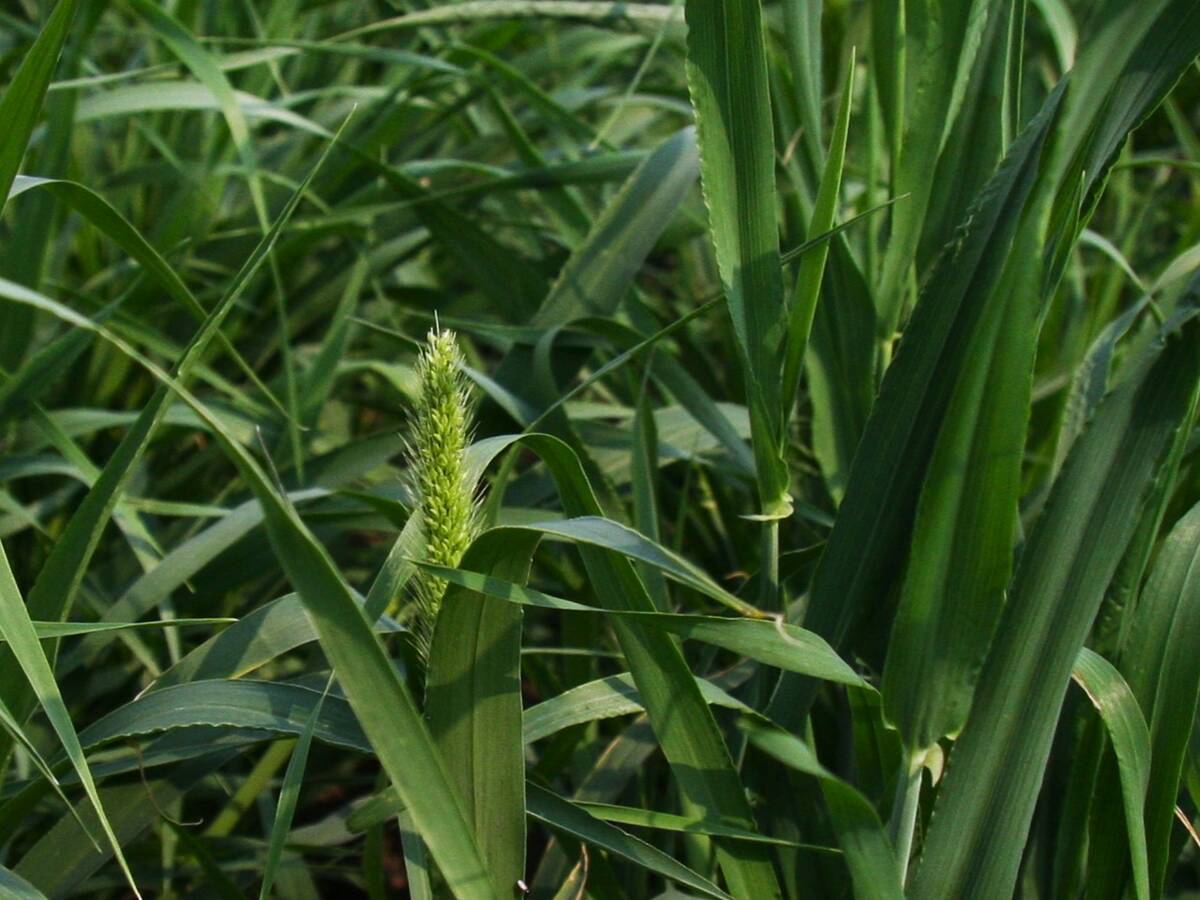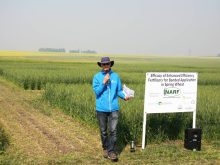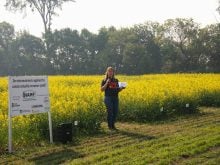Diversification of a field can be extremely beneficial — for the soil, future crops and a producer’s bottom line.
Kui Liu, an agronomy research scientist at Agriculture Canada, is leading a project trialling a barley varietal mix to increase diversity and mitigate environmental stressors.
“Some people call it the mixture “insurance,” he said.
Read Also

Fertilizer method’s link to emissions studied
A researcher says others studying greenhouse gas emissions aren’t considering how the loss of nitrogen into the atmosphere correlates with fertilizer application or if there is an impact to yield.
“You know, it can survive different environments compared with pure stands. I agree with that. And then I think when you diversify, you improve ecosystem services, so that’s enhancing the resilience, particularly stability.”
A plot with the barley mixture was on display at Agriculture Canada’s booth at Ag in Motion 2025, where producers could stop by, see how the mixture looked and ask questions.
Follow all our Ag in Motion coverage here
It’s a three-year feed barley trial and is currently in its second year. After the first year, the researchers noted a two per cent increase in yield compared to average rates. Liu expects to see stronger results at the end of this year, and again next year once the trial is completed and results can be compared.
Liu and his research team theorize that the varietal mix has an increased yield because of the higher diversity to combat environmental stressors, something that’s hard to achieve in a pure stand.
Liu said the Canadian Prairies operate with a simplified cropping system that if diversified or enhanced, could see improvement to the resilience and stability of the cropping system.
One way to achieve that is through a cultivar mixture, such as this project with four barley varieties. Liu’s chosen varieties ensure that the main issues producers face, such as disease, drought, pests and lodging, could be addressed by the mix.
“In a good environment, you do not need to diversify your system,” he said.
“But in a stressful environment, when you diversify your cropping system, because different crops have different traits, they may have different ability to cope with the stress.”
Part of the trial is to compare the mixed stand with pure variety stands on factors such as growth, stand stability and yield as well as testing for variances in above and below ground diversity.
“We know (that if) you increase the above ground diversity … sometimes you may stimulate below ground diversity,” Liu said.
“So, we measure soil microbial structure population to see how the cultivar improves the soil microbial structure.”
The project is ongoing at four sites across Canada, starting with Swift Current, Sask., and then stretching east to Brandon, Ottawa and Prince Edward Island.
The various locations highlight the impact and effects of different soils, precipitation and other environment roles.
Depending on the conditions, the varieties used in the mix may vary to best meet the area’s needs.
For example, a larger consideration in P.E.I. is high precipitation and disease risk, so the researchers have chosen to use different disease resistant varieties.
These variations are critical to Liu’s methods because one of his goals is to emulate what producers will use and the management methods they employ such as crop rotations and land management.
He also kept in mind the ease of using a mixed blend, noting managment of the crop itself is simple because there’s no changing of equipment settings for planting or variance in herbicides or fungicides that can be used on the crop.
Pairing this strategy with the information they gain, Liu will be able to provide recommendations to producers regarding which varieties to blend and at what ratio, depending on their conditions.
When designing a location’s trial, Liu has two approaches:
Ask breeders to identify the best recommended varieties for research goals, such as high yield, lodging resistance and fusarium head blight resistance.
Choose the top performing varieties from the region, which typically provides a strong sample of effective traits for an area.
The breeder recommendations are then mixed with top performers to compare.
“We basically use both approaches and then we balance,” he said.
“Because we need to consider the plant heights — you don’t want the plants one too short, one too high — and also, we consider the maturity dates — you want them to mature at the same date. So, we use multiple approaches to select the varieties.”
With the chosen varieties, it’s hard for anyone other than breeders to identify the pure stands from mixed. Liu said this is a good sign for uniformity and harvestability.
There are a few working theories about the reasons for yield increase and stability, but it ultimately comes down to balance.
“One of the theories is, for example, if there are disease outbreaks and then one variety is more resistant than another, that would be a dilution effect, right?” Liu said.

“Another (theory), one crop probably has a more efficient use of nutrients than the others, so they increase the nutrient use efficiency and recycling, and then they may better handle the stressful environments.”
Liu’s other theory relates to the functional diversification of the variety mix. By combining traits, the crops may perform better.
The team is quantifying these theories by comparing above and below ground results. This includes taking samples and measurements to quantify impacts to soil health, root health, microbes and plant heights and growth.
While analysis results aren’t yet available, Liu and his team will be able to identify the specific contributions of each variety and their associated traits to the varietal mix by the end of the study. Once this information is known and understood, they could build on the results by adjusting seeding rates for treating specific needs and strong yields.
“The concept for diversification is not just to increase the yield,” he said.
“It’s also the stability, the resilience that’s become more important under the stressful environment, under climate change. We see the frequency of droughts or heat, the pest outbreaks get more frequent, this stressful environment and how to deal with it, and then use the crop mixture, (it) may provide some partial solution.”
















